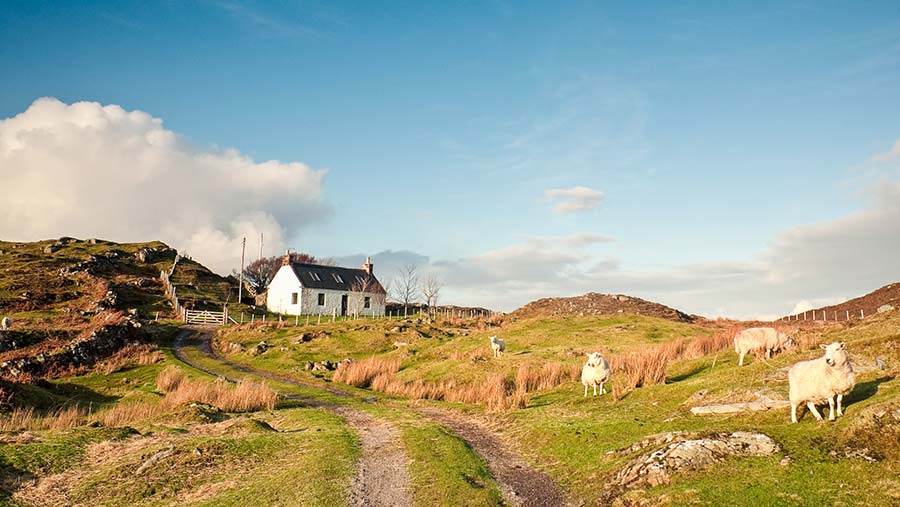LFA and ‘coupled’ supports at risk in Scottish policy plans
 © Travelwitness/Adobe Stock
© Travelwitness/Adobe Stock Money paid to Scottish farmers in the form of less favoured area (LFA) support and as “coupled” aid to suckler beef and upland sheep producers must be retained as direct income support in any future policy, says NFU Scotland.
Failure to do so risks undermining the financial viability of numerous farming and crofting businesses, it says, and would jeopardise the ability of the sector to deliver the government’s wider environmental and climate change objectives.
See also: Scots government sets out plans for future farm support
Addressing a webinar on the ongoing consultation for a new Scottish Agriculture Bill, NFUS policy director Jonnie Hall explained that, currently, old EU Pillar 1-style support made up the bulk of direct payments, upon which most farm businesses are so dependent.
Of a total support spend of £637m in Scotland, the Basic Payment Scheme (BPS) accounts for £282m and “greening” payments a further £142m, while the suckler beef and ewe hogg schemes pay another £47m in coupled supports.
And, while it is technically a Pillar 2 measure, the Less Favoured Area Support Scheme (LFASS) is worth a further £65m in direct payments to those farming in Scotland’s most challenging areas.
New-look support
While details in the consultation are scant, Mr Hall warned there was a real danger that a large chunk of that money would be lost as direct payments to farmers and be shifted into broader measures, such as farm advisory services, nature recovery and peatland restoration.
According to the consultation, the Scottish government is planning four broad areas of rural support (see graphic below). Tier 1 and Tier 2 will consist of direct payments, but with stricter conditions attached to both compared with existing cross-compliance.
But Tiers 3 and 4 will be indirect payments, with Tier 3 intended for future agri-environment measures, and Tier 4 for so-called “complementary support” – including knowledge transfer, skills development and tree planting.
Scottish government vision of agriculture support package beyond 2025 |
|||||
| Tier 1 and 2 direct payments | Tier 3 and 4 indirect payments | ||||
| Tier 1 | Tier 2 | Tier 3 | Tier 4 | ||
| People development |
|
||||
|
|
|
|
|
|
| Management tools | |||||
|
|
||||
| Source: Scottish government | |||||
“If you read the consultation document, it is very clear that to make up the future Tier 1 and Tier 2 schemes, the Scottish government is looking at utilising the existing pots of money in both the BPS and greening components,” Mr Hall told the seminar.
“But where will the coupled support go? And where has LFASS gone?
“We will argue very strongly that those components need to be driven into Tier 1 and Tier 2 as well, whereas the consultation suggests that coupled support and LFASS support in the future would be in their so-called Tier 4 of ‘complementary measures’.
“We think there is definitely scope to have that coupled support as a Tier 2 enhanced payment. And we’ve said from day one we need an element of less favoured area support as a top-up to the Tier 1 base direct payment.”
Unanswered questions
Mr Hall noted that there were many other unanswered questions from the consultation, including:
- Whether future direct payments will still be targeted according to land type (arable, grassland or rough grazing)
- What further conditions might be attached to any direct payments (the government is talking about enhanced conditions and having a ‘whole farm plan’)
- Will there be capping or tapering of payments (as provided for in the Agriculture Bill proposals)?
- What level of funding will there be post-2024?
NFUS says it has a preference for a direct payment system under Tier 1 based on a single region with a flat rate, targeted at active farmers and kept as simple as possible.
“If this base payment, which is so fundamental to the viability of a business, ends up being something that we have to involve a third party to ensure that we get it right, or ends up involving additional costs or indeed income forgone, then all it’s doing is eroding the bottom line,” said Mr Hall.
As for redistribution, NFUS would be in favour of some form of “front loading”, with an uplift in payments on the first number of hectares, but it remains opposed to capping payments or tapering them down above a certain size of holding.
Mr Hall also warned against attaching too many strings to Tier 2 schemes – for going “above and beyond” Tier 1 in terms of nature restoration and reducing greenhouse gas emissions.
“If we end up making Tier 2 too difficult, too costly, too onerous, too many tripwires – nobody will touch it,” he said.
On the future budget, Mr Hall said this was the “elephant in the room”, but with a new prime minister and chancellor, “all bets are off” about the chances of keeping the £620m a year that currently comes from Westminster.
To take part in the consultation before it closes on 21 November, visit the consultation website and have your say.
